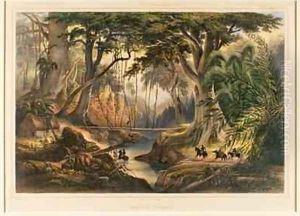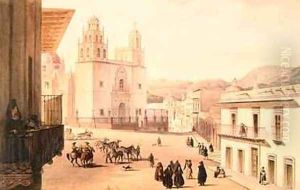Carlos Nebel Paintings
Carlos Nebel, also known as Karl Nebel, was a notable 19th-century artist and engineer born in 1805 in Altona, which at the time was part of the Danish monarchy and is today a district of Hamburg, Germany. His work is particularly important for the documentation of the landscapes, architecture, and everyday life in Mexico and the American South during his travels in the early 19th century.
Nebel received his education in Germany and displayed a keen interest in both art and engineering from an early age. His skills as a draughtsman and his technical background would later greatly influence his artistic work, which is characterized by meticulous detail and accuracy.
In 1829, Nebel traveled to Mexico, a trip that would have a profound impact on his career. He spent several years in the country during a period of significant political change and turmoil following Mexico's independence from Spain. During his stay, Nebel documented the Mexican landscape, its monuments, and scenes from the Mexican-American War. His lithographs and paintings are valuable historical records of this era.
Nebel's most significant work is his collection of lithographs published in 1836 under the title 'Voyage pittoresque et archéologique dans la partie la plus intéressante du Mexique' (Picturesque and Archaeological Voyage in the Most Interesting Part of Mexico). The publication contained 50 lithographs that portrayed the rich cultural heritage of Mexico, including its pre-Columbian architecture, colonial buildings, and various city views. This work was not only artistically acclaimed but also served as an important ethnographic and archaeological record.
After his time in Mexico, Nebel also traveled to the United States, where he focused on capturing the architecture and landscapes of the American South. His works from this period further established his reputation as a skilled observer and delineator of the world around him.
Carlos Nebel died in 1855, leaving behind a legacy as a significant chronicler of his time through his detailed and evocative artwork. His contributions provide an invaluable window into the 19th century's cultural and historical landscapes in Mexico and the American South, making him an important figure in the world of historical illustration and art history.

